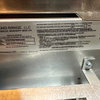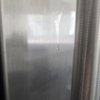Fumehood Checklist
I'm embarking on a kitchen reno and am looking for a high quality, 36" wide, wall-mounted fumehood for over our gas stove top. I want the fan to be quiet, and it needs to be powerful enough to vent fumes and odours effectively. Ang advice is appreciated. ☺️
Comments (11)
catinthehat
6 years agoJust to add another layer of detail, CFM ratings are listed with no real advertising standard. Always look up the blower curves. This may be a level of detail beyond what most people would do, but if you want to guarantee a useful setup for your custom scenario it's the only way. Sorry I do not have experience beyond the manufactures I researched, but Prizer/Bluestar's entire line of hood blowers include blower curves online. My 1400 cfm remote blower is actually rated at 1450 cfm for less than 10 feet of 10 inch duct run, but more impressive is its ability to maintain 1380 cfm with 70 feet of equivalent ductwork.kaseki
6 years agoThe pressure loss in the baffles will generally exceed that of the ducting. Baffles usually aren't included in the fan curve plot. Also, the pressure loss in the method used to provide make-up air also has to be accounted for.
catinthehat
6 years agoCorrect, the blower curve is just that. No assumptions are made for what kind of hood setup you integrate. In my particular case the pressure drop from the hood/baffled was a bit less than my ductwork, it really depends on the individual setup.opaone
6 years agolast modified: 6 years agoMost standard baffles seem to be about 0.25" @ 600 cfm and 0.60" @ 1000 cfm. This is for a single baffle so if you have a hood with 3 of these (side by side) then you can divide by 3. So, an expected 1000 cfm system would be about 0.2" for the baffles. If you want to be anal then it's recursive so will be a bit less (though likely not enough to worry about).
When you get in to better filters (Captrate for example) then the static pressure increases dramatically to perhaps 3" @ 1000 cfm. These remove significantly more grease though.
catinthehat
6 years agoWow 3"!! I'll have to look at my blower curve again, but I don't think residential blowers could handle that, even my 1400cfm model. After I researched how inefficient these baffles that come with residential hoods are, I was thinking of upgrading the baffles off the batt. I should currently be able to capture approximately 350 cfm/ft, so I have some room. Unfortunately the curve isn't flat enough from what I recall. I wish prizer/bluestar included an efficiency plot along with the flow data.
opaone
6 years agoOP, there are several things to consider; capture area, containment area, and evacuation the key bits. If you search for kaseki's posts you'll find some good info. Briefly though, capture is basically the width and depth (side to side and front to back) of your hood interior. For a wall hood this should ideally be about 10-12" wider than your range (6" either side) and come out about 6" farther. Smaller dimensions will allow more grease, odor and steam laden air in to your kitchen.
Containment is the area to hold effluent prior to evacuation. Ideally this s/b about 24" though beyond 12" can be diminishing returns so 12" is enough. Less than 12" begins to produce significant underflow back in to the kitchen. Most consumer hoods, as mentioned above, fail miserably on this bit.
Evacuation is the baffle, blower, and ducts which must be sized appropriate for both the hood size and the expected amount of effluent.
Most consumer hoods (always undersized in capture, containment, and evacuation) will remove only about 10-15% as much effluent as commercial products. Some a bit more, some much less. In our case we are likely going with a CaptiveAire commercial hood liner and blower system. We really don't want greasy odor in our new kitchen.
opaone
6 years agolast modified: 6 years ago"Wow 3"!! I'll have to look at my blower curve again, but I don't think residential blowers could handle that, even my 1400cfm model."
Yep, static pressure can add up quickly. Most people, even a surprising number of HVAC folk, don't realize that a 60cfm bath ceiling fan may only produce an actual 5-10cfm once ducted with the average flex duct used by most HVAC folk. A perfectly straight run of rigid duct to an exhaust cap on the roof might only reduce it to 50cfm.
kaseki
6 years agoThe primary reason why I suggest 90 CFM/sq.ft. actual at the hood entry aperture is to ensure that the effluent otherwise reflecting from the baffle and hood structures (due to conservation of momentum) is entrained in the 180 ft/min or higher flow velocity entering the baffle gaps. This gap velocity value is commensurate with the actual plume velocity.
The term "containment" in the vent hood industry refers to getting the effluent past the baffles. I would call the volume under the baffles the capture volume.
One point I've come to realize is that slow cooking of greasy foods (think bacon, for example) will generate a relatively low effluent rising velocity that can be successfully captured and contained using a low blower setting. However, the centrifugal grease extraction in the baffles will be poor at the flow velocity resulting from that setting. If one wants to collect as much grease as possible, the blower will need to be set higher than needed for just capture and containment.
Residential hoods may present a range of pressure losses. (Hood internal transition losses are included in the following, and are likely significant when the hood is large but must transition to a constrained duct diameter. Also not to be forgotten is the transition loss at the hood entry aperture, and the effects of abrupt flow direction changes within the hood.)
I have Wolf supplied Broan-NuTone fan curves with superimposed pressure loss curves (by effective duct length) that indicate (for some hoods not specified, but I believe them to be the "Pro" hoods I was discussing with them which have most of the intake aperture faced by baffles) pressure losses of 0.75 inches at about 850 CFM (1200 CFM external blower) with zero feet of duct, and about 0.32 inches at 540 CFM (600 CFM external blower) with zero feet of duct.
For my 1500 CFM external blower (Wolf 804701) I assume the baffle/hood loss to be an inch at 1000 CFM across 10 hood baffle sections including hood losses. This Pro Island hood has about 10 square feet of entrance aperture. This is equivalent to an inch at 100 CFM per baffle section (including a share of unknown hood losses). I don't think we should attribute less than 0.5 inches of pressure loss to the baffles alone.
As an overall vent system, however, when accounting for other losses the flow will be lower with this blower and hood. I'm guessing about 900 CFM at about 1.2 inches when my MUA is finally completed and optimized. Duct is 10-inch for roughly 20 feet and includes a Fantech silencer.
catinthehat
6 years ago@kaseki Thanks kaseki very informative. Like you I am a bit obsessed with filter performance, primarily because I don't want my remote blower getting gunked up. Interesting how lower velocity settings may end up always being a poor choice no matter what fatty food you cook. I'll admit I did not assume a pressure drop of .5" across my baffles, but maybe I actually want something higher to get better capture. My own setup includes 25 ft of 10" vent with 1.5 bends and a fantech silencer with remote 1400 cfm blower. If you have a minute, I have a thread in the kitchen forum regarding make up air placement I would appreciate your thoughts on. Thanks!
kaseki
6 years agoSteven: If you would provide a link, I won't have to hunt for it.
I'd be surprised if a remote blower became gunked-up in a time span less than decades. What I expect you will find, unless you grill chickens or wok 24/7, is a thin veneer of dried grease coating the interior of the ducting and perhaps the fan blades.
+++++ readers easily annoyed by extended comments should skip this part +++++++
Once upon a time we had a Litton unit that comprised an oven, a cooktop, and a microwave oven. The microwave oven was above the cooktop, and had a fan in a plenum above it. The plenum connected via a narrow duct in the rear of the microwave to a mesh filter under the microwave oven. The plenum also had a door in the front that could open and perform the task of an eyebrow vent. This door opening also had a mesh filter. The fan in the plenum would have been hard put to move 100 CFM in open air. The fan port was ducted to a roof cap.
At some point during the late '70s, I think, I increased the duct size and put a small down-blast NuTone blower on the roof. This modestly improved air flow. In any case, the meshes easily became lint and grease coated, requiring cleaning.
For our 2007 - 2011 kitchen reno, I re-purposed this roof blower to perform venting from a pair of ceiling registers mounted over the wall ovens. At that time the original stove/cooktop/microwave oven unit was junked, and the ducting revised. (It now includes its own silencer.) There was only a film of grease in the original ducting, and I saw no need to replace or even clean the roof blower. The reason is that NuTone fans were guaranteed for life. As it turned out, life was re-defined to be 10 years after Broan bought NuTone. In any case, blower life of my many different blowers tends to be decades, and hence I didn't feel that I needed to do preventative replacement.
++++++++++++++++++++++++++++++ TL;DR +++++++++++++++++++++++++++++++++
Residential grease generation is orders of magnitude lower than is typical of most restaurants. You should not need to perform an inspection every year, or have the ducting cleaned every year. What grease vapor makes it to the blades will tend to be centrifugally expelled to the blower wall areas, and this will typically drain or dry. I recently looked below my 1500 CFM Wolf/Broan down-slope roof blower to see if there was any grease visible on the roof and there wasn't. If any makes it there it is likely broken down by UV in the summer.







barryv_gw